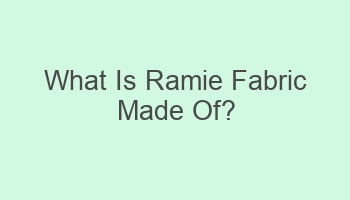What Is Ramie Fabric Made Of?

Ramie fabric is made from the fibers of the ramie plant, also known as China grass. This sustainable textile is derived from the stem of the plant, which is native to East Asia. The process involves retting the plant to extract the fibers. Ramie fabric is known for its durability, breathability, and lustrous appearance. The fibers are ecofriendly and biodegradable, making ramie fabric a popular choice for sustainable fashion enthusiasts.
Contents
| Ramie fabric is made from natural fibers extracted from the Ramie plant. |
| It is known for its strength, durability, and ability to hold shape. |
| Ramie fibers are lustrous and have a natural sheen to them. |
| It is often used as a sustainable alternative to cotton and linen. |
| Ramie fabric is breathable, making it ideal for warm weather clothing. |
- It is resistant to bacteria and mildew, making it a great choice for clothing.
- Ramie fabric is lightweight and has excellent moisture absorption properties.
- It is often blended with other fibers such as cotton or polyester.
- Ramie fabric is easy to care for and can be machine washed.
- It is biodegradable and environmentally friendly, making it a sustainable choice.
What Is Ramie Fabric Made Of?
Ramie fabric is made from the fibers of the ramie plant, also known as China grass or white ramie. It is a natural fiber that comes from the stem of the plant, which is harvested and processed to create the fabric.
- Ramie fibers are extremely strong and durable, making them ideal for use in textiles.
- The fibers are smooth and lustrous, giving ramie fabric a natural sheen that is similar to linen.
- Ramie fabric is breathable and absorbent, making it a comfortable choice for clothing in warm weather.
Where Does Ramie Fabric Come From?
Ramie fabric comes from the ramie plant, which is native to East Asia. The plant is grown in countries like China, India, and Indonesia, where the climate is suitable for its cultivation.
| Ramie plants are perennial crops that can be harvested multiple times a year. |
| The fibers are extracted from the plant’s stem through a process called decortication. |
Why Is Ramie Fabric Sustainable?
Ramie fabric is considered sustainable because the ramie plant requires minimal water and pesticides to grow. It is a fast-growing plant that can be harvested multiple times, making it environmentally friendly.
- Unlike cotton, ramie does not require as much water, making it a more sustainable choice for textile production.
- Ramie plants are pest-resistant, reducing the need for harmful pesticides that can damage the environment.
How Is Ramie Fabric Processed?
The process of turning ramie fibers into fabric involves several steps, including harvesting, retting, decortication, spinning, and weaving. Each step is essential to create high-quality ramie fabric.
| After harvesting the ramie plant, the fibers are extracted through a process called retting, which involves soaking the stems to separate the fibers. |
| Decortication is the process of removing the outer layer of the stem to reveal the inner fibers, which are then spun into yarn and woven into fabric. |
Can Ramie Fabric Be Dyed?
Ramie fabric can be dyed using natural or synthetic dyes. The fibers have good dye affinity, allowing them to absorb and retain colors well.
- Natural dyes like indigo and madder can be used to color ramie fabric in earth tones and pastels.
- Synthetic dyes offer a wider range of colors and shades, allowing for bolder and brighter hues in ramie textiles.
Is Ramie Fabric Biodegradable?
Ramie fabric is biodegradable, meaning it can break down naturally over time without causing harm to the environment. This makes it a sustainable choice for eco-conscious consumers.
| When disposed of, ramie fabric will decompose and return to the earth, unlike synthetic fabrics that can linger in landfills for years. |
What Are the Benefits of Ramie Fabric?
Ramie fabric offers several benefits, including breathability, durability, and antibacterial properties. It is a versatile material that can be used for a variety of textile applications.
- Ramie fabric is resistant to bacteria and mildew, making it a good choice for clothing and linens.
- It is crease-resistant and holds its shape well, even after multiple washes.
How Does Ramie Fabric Compare to Other Fabrics?
Ramie fabric is often compared to linen due to its similar appearance and properties. However, ramie is stronger and more lustrous than linen, making it a preferred choice for certain applications.
| Ramie fabric is lightweight and breathable, similar to linen, but it tends to wrinkle less and has a silky texture. |
Is Ramie Fabric Suitable for All Skin Types?
Ramie fabric is hypoallergenic and gentle on the skin, making it suitable for all skin types. It is a natural material that is breathable and comfortable to wear.
- People with sensitive skin or allergies may find ramie fabric to be a good choice for clothing and bedding.